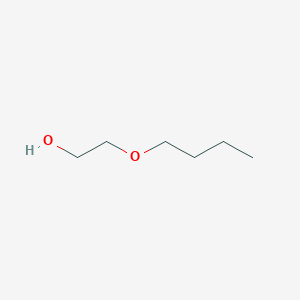-
Categories
-
Pharmaceutical Intermediates
-
Active Pharmaceutical Ingredients
-
Food Additives
- Industrial Coatings
- Agrochemicals
- Dyes and Pigments
- Surfactant
- Flavors and Fragrances
- Chemical Reagents
- Catalyst and Auxiliary
- Natural Products
- Inorganic Chemistry
-
Organic Chemistry
-
Biochemical Engineering
- Analytical Chemistry
- Cosmetic Ingredient
-
Pharmaceutical Intermediates
Promotion
ECHEMI Mall
Wholesale
Weekly Price
Exhibition
News
-
Trade Service
At the closing ceremony of the 4th World Forum on Science and Technology and Development held recently, Shuai Zhigang, member of the Executive Committee of the International Union of Pure and Applied Chemistry (IUPAC) and vice president of the Chinese Chemical Society, released the top ten emerging technologies
in the field of IUPAC chemistry in 2022 。 These ten emerging technologies include a number of research projects led by Chinese chemists, such as nanoenzymes led by the team of Academician Yan Xiyun of the Institute of Biophysics of the Chinese Academy of Sciences, thin-film fluorescent sensors led by the team of Academician Fang Yu of Shaanxi Normal University, liquid solar fuel led by the team of Academician Li Can of the Dalian Institute of Chemistry, Chinese Academy of Sciences, and fiber batteries and fabric displays
led by the team of Professor Peng Huisheng of Fudan University.
Nanozymes: a new means of disease diagnosis and treatment
Nanozymes are a magical nanomaterial
.
It has the properties of natural enzymes, can efficiently catalyze enzyme substrates under mild conditions, produce the same reaction products as natural enzymes, and can be used as an enzyme substitute to regulate cell metabolism for disease diagnosis and treatment
.
Unlike natural enzymes, which can only operate over a specific temperature and pH range, nanoenzymes can withstand harsh conditions and enable long-lasting, safe and stable storage
.
The nanozyme was first published and named internationally by Yan Xiyun's
team in 2007.
International peers believe that this is a landmark event
in the history of enzymology.
It can be said that the discovery of nanozymes has blurred the boundary between inorganic materials and organic organisms, and promoted the integration
of nanoscience and medicine.
Yan Xiyun's team has long been committed to the mechanism and application research of nanoenzymes, and has developed a number of new technologies
based on nanoenzymes.
They designed and developed nanozyme test strips for disease diagnosis, becoming the world's first new nanozyme product; By creating multi-enzyme active nanoenzymes, peroxidase activity was initiated by using the tumor microenvironment to catalyze the production of reactive oxygen species to kill tumor cells, and new strategies
for nanoenzyme-catalyzed therapy were explored.
His research achievements in the application of nanozymes have won the second prize of National Natural Science Award and the Atlas International Award
.
At present, 290 laboratories in 29 countries around the world are engaged in more than 300 nanoenzyme research, and the applied research involves biology, medicine, agriculture, environmental governance, etc.
, forming a new research field
.
Thin-film fluorescence sensors: efficient and sensitive detection equipment
Thin-film fluorescence sensing is considered to be the most promising microtrace detection technology
after ion mobility spectroscopy due to its excellent sensitivity, selectivity, tunability and universality.
In the corresponding devices, molecules with fluorescent activity are usually fixed on suitable matrices with sizes as small as 1 cm or less, forming 2D or 3D thin film materials with rapid and reversible response to external stimuli, and performing efficient detection functions for microtrace substances
.
This type of fluorescent sensor has the advantages of small size, low power consumption and simple operation, and has outstanding advantages
in the creation of portable sensors.
Since 1998, Fang Yu's team has carried out in-depth and comprehensive research on the problems that thin film fluorescence sensing in fluorescence sensing technology is easily interfered by environmental factors, selectivity and sensitivity
, and it is difficult to meet special detection needs.
At present, the Fangyu team has used thin-film fluorescence sensors to efficiently detect explosives (trinitrotoluene), atmospheric pollutants (ammonia compounds, nitrogen oxides, organic volatiles), as well as pesticides, nerve agents, nicotine, pathogens, etc.
, and has created the fastest response and highest sensitivity to date explosives and drug thin-film fluorescence detection records
.
The drug film fluorescence sensor and detection equipment pioneered by Fang Yu's team have also begun to be applied
.
The development of thin-film fluorescent sensors and equipment for ultra-sensitive detection of high-risk substances such as nerve agents and pathogens is also progressing
in an orderly manner.
Liquid solar fuel: bottled renewable energy
Plants convert carbon dioxide and solar energy into glucose
through photosynthesis.
Similarly, chemists simulate this process
by creating "artificial photosynthesis.
" Liquid solar fuel technology is such an artificial photosynthesis technology that simulates natural photosynthesis, using solar energy, water and carbon dioxide to produce energy-rich substances such as methanol, which is expected to replace current fossil-derived fuels
.
In addition, liquid solar fuel, like batteries, offers new opportunities
for intermittent renewable energy storage.
Liquid solar fuel technology is therefore considered a strategy for "bottled renewable energy" and the production of
green chemicals.
Solar fuel demonstration plants have begun to appear around the world, and investment institutions in the United States, Europe and Asia are promoting cooperation
in the technology.
In 2019, Li Can's team cooperated with Lanzhou New District Petrochemical Industry Investment Group to launch the first domestic solar fuel production demonstration project - carbon dioxide hydrogenation synthesis methanol technology development project
in Lanzhou New District.
In January 2020, the project successfully commissioned for the first time and produced 60% crude methanol, taking the first step
in the industrial production of liquid solar fuel.
The liquid solar fuel synthesis project was listed as a highlight of the transformation of major scientific and technological achievements in the first quarter of 2020 of the Chinese Academy of Sciences, and won the first prize of scientific and technological invention of the 2021 China Renewable Energy Society and the gold medal
of the first Hong Kong TERA-Award Smart Energy Innovation Competition.
Fiber batteries: a new choice for wearables
The structure of fiber batteries is completely different from traditional batteries, showing a nearly one-dimensional design, with soft, stable and safe advantages
.
In addition, the battery "fabric" woven from fiber batteries can adapt to many different deformations and applications, making it more suitable for wearable electronic devices
.
When electronic devices are developing in the direction of miniaturization, flexibility and integration, the mainstream research direction in the academic community is thin film, but fiber batteries are rarely interested
.
Many scientists believe that the internal resistance of fiber batteries increases with the increase of length, and it is impossible to achieve high-performance and large-scale application of batteries
.
Peng Huisheng's team has found in years of research that there is a unique hyperbolic cotangent function relationship between the internal resistance and the length of fiber lithium-ion batteries, that is, the internal resistance does not increase with the increase of length, but first decreases and then tends to stabilize
.
Under the guidance of this theory, the fiber lithium-ion battery constructed by the team has excellent and stable electrochemical performance, the energy density is increased by nearly 2 orders of magnitude compared with the past, and the capacity retention rate exceeds 80%
after 100,000 bends.
The team also achieved large-scale continuous production of fiber batteries and established the world's first fiber lithium-ion battery production line
.
It produces fiber lithium-ion battery systems with comparable electrochemical performance to commercial lithium-ion batteries, while providing better
stability and safety.
Companies such as Samsung and Huawei are also studying the application potential of fiber batteries, and their market size will grow
with the development of industries such as wearables and printed electronics.
Fabric display: A monitor worn on the body
With the rise of high-speed communication and connected devices, researchers began to explore
in the field of fabric displays.
Such devices will revolutionize electronics and how they interact, and lead to the commercialization
of a new generation of wearable electronic devices and smart textiles.
In traditional approaches, wearable devices rely on thin-film displays attached to the surface of fabrics and textiles
.
The method of fabric display devices is completely different, directly weaving the light-emitting fibers into soft fabric displays
.
Peng Huisheng's team developed two functional fibers, polymer composite fibers loaded with luminescent active materials and transparent conductive polymer gel fibers, through which the warp and weft of the two are interwoven in the weaving process to form electroluminescent units, and a new flexible display fabric
is prepared through effective circuit control.
Compared with traditional flat light-emitting devices, the diameter of the light-emitting fiber of the fabric display can be precisely adjusted in 0.
2~0.
5 mm, making it ultra-fine and ultra-flexible
.
The garment woven in this way can follow the irregular contours of the human body, and is as light and breathable as ordinary fabric, ensuring good wearing comfort
.
Researchers are investigating the possibility of
fabricating fabric displays at scale.
Although its application is currently mainly focused on the field of wearable devices, large-area fabric displays are expected to be used in homes and advertising in the future
.
(Chen Fei)
From: China Chemical Industry News
Return to Sankei homepage >>
2022 Top 10 Emerging Technologies in the Field of Chemistry Released Chinese chemists lead research and occupy five seats
Welcome here







